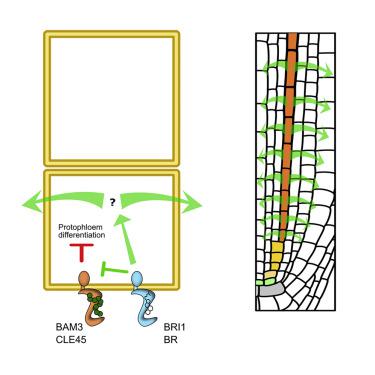当前位置:
X-MOL 学术
›
Curr. Biol.
›
论文详情
Our official English website, www.x-mol.net, welcomes your
feedback! (Note: you will need to create a separate account there.)
Local and Systemic Effects of Brassinosteroid Perception in Developing Phloem.
Current Biology ( IF 8.1 ) Pub Date : 2020-03-26 , DOI: 10.1016/j.cub.2020.02.029 Moritz Graeff 1 , Surbhi Rana 1 , Petra Marhava 1 , Bernard Moret 1 , Christian S Hardtke 1
Current Biology ( IF 8.1 ) Pub Date : 2020-03-26 , DOI: 10.1016/j.cub.2020.02.029 Moritz Graeff 1 , Surbhi Rana 1 , Petra Marhava 1 , Bernard Moret 1 , Christian S Hardtke 1
Affiliation

|
The plant vasculature is an essential adaptation to terrestrial growth. Its phloem component permits efficient transfer of photosynthates between source and sink organs but also transports signals that systemically coordinate physiology and development. Here, we provide evidence that developing phloem orchestrates cellular behavior of adjacent tissues in the growth apices of plants, the meristems. Arabidopsis thaliana plants that lack the three receptor kinases BRASSINOSTEROID INSENSITIVE 1 (BRI1), BRI1-LIKE 1 (BRL1), and BRL3 ("bri3" mutants) can no longer sense brassinosteroid phytohormones and display severe dwarfism as well as patterning and differentiation defects, including disturbed phloem development. We found that, despite the ubiquitous expression of brassinosteroid receptors in growing plant tissues, exclusive expression of the BRI1 receptor in developing phloem is sufficient to systemically correct cellular growth and patterning defects that underlie the bri3 phenotype. Although this effect is brassinosteroid-dependent, it cannot be reproduced with dominant versions of known downstream effectors of BRI1 signaling and therefore possibly involves a non-canonical signaling output. Interestingly, the rescue of bri3 by phloem-specific BRI1 expression is associated with antagonism toward phloem-specific CLAVATA3/EMBRYO SURROUNDING REGION-RELATED 45 (CLE45) peptide signaling in roots. Hyperactive CLE45 signaling causes phloem sieve element differentiation defects, and consistently, knockout of CLE45 perception in bri3 background restores proper phloem development. However, bri3 dwarfism is retained in such lines. Our results thus reveal local and systemic effects of brassinosteroid perception in the phloem: whereas it locally antagonizes CLE45 signaling to permit phloem differentiation, it systemically instructs plant organ formation via a phloem-derived, non-cell-autonomous signal.
中文翻译:

油菜素类固醇感知在韧皮部发育中的局部和全身效应。
植物脉管系统是对陆地生长的基本适应。它的韧皮部成分允许光合作用在源和汇器官之间有效转移,但也传输系统协调生理和发育的信号。在这里,我们提供的证据表明,发育中的韧皮部会协调植物生长顶点(分生组织)中相邻组织的细胞行为。缺乏三种受体激酶 BRASSINOSTEROID INSENSITIVE 1 (BRI1)、BRI1-LIKE 1 (BRL1) 和 BRL3(“bri3”突变体)的拟南芥植物不能再感知油菜素类固醇植物激素并表现出严重的侏儒症以及模式和分化缺陷,包括扰乱韧皮部发育。我们发现,尽管油菜素类固醇受体在生长中的植物组织中普遍存在,BRI1 受体在韧皮部发育中的唯一表达足以系统地纠正 bri3 表型基础的细胞生长和模式缺陷。虽然这种效应是油菜素类固醇依赖性的,但它不能用已知的 BRI1 信号下游效应器的主要版本复制,因此可能涉及非规范信号输出。有趣的是,韧皮部特异性 BRI1 表达对 bri3 的拯救与对根中韧皮部特异性 CLAVATA3/胚胎周围区域相关 45 (CLE45) 肽信号传导的拮抗作用有关。过度活跃的 CLE45 信号导致韧皮部筛分元素分化缺陷,并且一致地,在 bri3 背景中敲除 CLE45 感知可以恢复适当的韧皮部发育。然而,bri3侏儒症保留在这样的品系中。
更新日期:2020-03-26
中文翻译:

油菜素类固醇感知在韧皮部发育中的局部和全身效应。
植物脉管系统是对陆地生长的基本适应。它的韧皮部成分允许光合作用在源和汇器官之间有效转移,但也传输系统协调生理和发育的信号。在这里,我们提供的证据表明,发育中的韧皮部会协调植物生长顶点(分生组织)中相邻组织的细胞行为。缺乏三种受体激酶 BRASSINOSTEROID INSENSITIVE 1 (BRI1)、BRI1-LIKE 1 (BRL1) 和 BRL3(“bri3”突变体)的拟南芥植物不能再感知油菜素类固醇植物激素并表现出严重的侏儒症以及模式和分化缺陷,包括扰乱韧皮部发育。我们发现,尽管油菜素类固醇受体在生长中的植物组织中普遍存在,BRI1 受体在韧皮部发育中的唯一表达足以系统地纠正 bri3 表型基础的细胞生长和模式缺陷。虽然这种效应是油菜素类固醇依赖性的,但它不能用已知的 BRI1 信号下游效应器的主要版本复制,因此可能涉及非规范信号输出。有趣的是,韧皮部特异性 BRI1 表达对 bri3 的拯救与对根中韧皮部特异性 CLAVATA3/胚胎周围区域相关 45 (CLE45) 肽信号传导的拮抗作用有关。过度活跃的 CLE45 信号导致韧皮部筛分元素分化缺陷,并且一致地,在 bri3 背景中敲除 CLE45 感知可以恢复适当的韧皮部发育。然而,bri3侏儒症保留在这样的品系中。











































 京公网安备 11010802027423号
京公网安备 11010802027423号